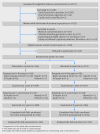Effectiveness of two year balance training programme on prevention of fall induced injuries in at risk women aged 75-85 living in community: Ossébo randomised controlled trial
- PMID: 26201510
- PMCID: PMC4511529
- DOI: 10.1136/bmj.h3830
Effectiveness of two year balance training programme on prevention of fall induced injuries in at risk women aged 75-85 living in community: Ossébo randomised controlled trial
Abstract
Objective: To assess the effectiveness of a two year exercise programme of progressive balance retraining in reducing injurious falls among women aged 75-85 at increased risk of falls and injuries and living in the community.
Design: Pragmatic multicentre, two arm, parallel group, randomised controlled trial.
Setting: 20 study sites in 16 medium to large cities throughout France.
Participants: 706 women aged 75-85, living in their own home, and with diminished balance and gait capacities, randomly allocated to the experimental intervention group (exercise programme, n=352) or the control group (no intervention, n=354).
Intervention: Weekly supervised group sessions of progressive balance training offered in community based premises for two years, supplemented by individually prescribed home exercises.
Outcome measures: A geriatrician blinded to group assignment classified falls into one of three categories (no consequence, moderate, severe) based on physical damage and medical care. The primary outcome was the rate of injurious falls (moderate and severe). The two groups were compared for rates of injurious falls with a "shared frailty" model. Other outcomes included the rates of all falls, physical functional capacities (balance and motor function test results), fear of falling (FES-I), physical activity level, and perceived health related quality of life (SF-36). Analysis was by intention to treat.
Results: There were 305 injurious falls in the intervention group and 397 in the control group (hazard ratio 0.81, 95% confidence interval 0.67 to 0.99). The difference in severe injuries (68 in intervention group v 87 in control group) was of the same order of magnitude (0.83, 0.60 to 1.16). At two years, women in the intervention group performed significantly better on all physical tests and had significantly better perception of their overall physical function than women in the control group. Among women who started the intervention (n=294), the median number of group sessions attended was 53 (interquartile range 16-71). Five injurious falls related to the intervention were recorded.
Conclusion: A two year progressive balance retraining programme combining weekly group and individual sessions was effective in reducing injurious falls and in improving measured and perceived physical function in women aged 75-85 at risk of falling.Trial registration ClinicalTrials.gov (NCT00545350).
© El-Khoury et al 2015.
Conflict of interest statement
Competing interests: All authors have completed the Unified Competing Interest form at
Figures




Comment in
-
Better balance, fewer falls.BMJ. 2015 Jul 23;351:h3930. doi: 10.1136/bmj.h3930. BMJ. 2015. PMID: 26206565 No abstract available.
-
Questions that need clarifying before implementation of the Ossébo balance training programme.BMJ. 2015 Sep 30;351:h5105. doi: 10.1136/bmj.h5105. BMJ. 2015. PMID: 26423592 No abstract available.
-
Authors' reply to Bonten.BMJ. 2015 Sep 30;351:h5116. doi: 10.1136/bmj.h5116. BMJ. 2015. PMID: 26424361 No abstract available.
-
ACP Journal Club: a balance retraining exercise program reduced injurious falls in at-risk older community-dwelling women.Ann Intern Med. 2015 Nov 17;163(10):JC2. doi: 10.7326/ACPJC-2015-163-10-002. Ann Intern Med. 2015. PMID: 26571256 No abstract available.
-
A balance retraining program reduces injurious falls and improves physical function in older women at risk of falling [commentary].J Physiother. 2016 Jan;62(1):48. doi: 10.1016/j.jphys.2015.09.004. Epub 2015 Dec 10. J Physiother. 2016. PMID: 26687950 No abstract available.
-
A balance retraining program reduces injurious falls and improves physical function in older women at risk of falling [synopsis].J Physiother. 2016 Jan;62(1):48. doi: 10.1016/j.jphys.2015.09.002. Epub 2015 Dec 11. J Physiother. 2016. PMID: 26701162 No abstract available.
References
-
- Rubenstein LZ. Falls in older people: epidemiology, risk factors and strategies for prevention. Age Ageing 2006;35(suppl 2):37-41. - PubMed
-
- Kannus P, Sievänen H, Palvanen M, et al. Prevention of falls and consequent injuries in elderly people. Lancet 2005;366:1885-93. - PubMed
-
- Sherrington C, Whitney JC, Lord SR, et al. Effective exercise for the prevention of falls: a systematic review and meta-analysis. J Am Geriatr Soc 2008;56:2234-43. - PubMed
Publication types
MeSH terms
Associated data
LinkOut - more resources
Full Text Sources
Other Literature Sources
Medical
Miscellaneous
